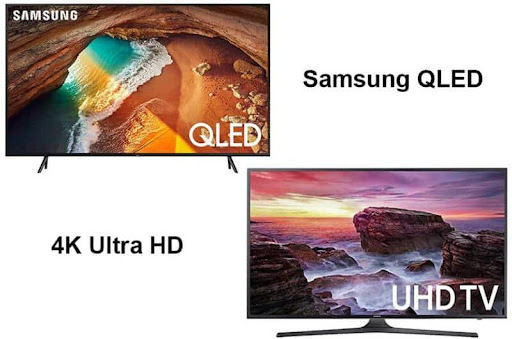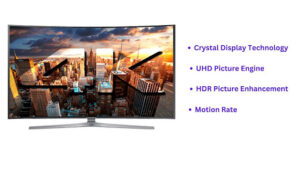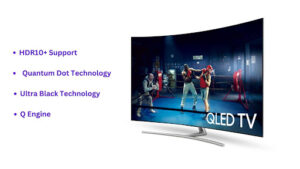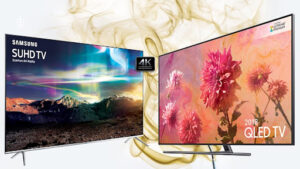Crystal UHD and QLED are both technologies used in modern television sets to improve picture quality, but they differ in some key ways.
Crystal UHD, also known as 4K or Ultra HD, refers to the resolution of the TV screen. A Crystal UHD TV has four times the number of pixels as a standard high-definition (HD) TV, resulting in a more detailed and clearer picture. Crystal UHD technology is commonly used in mid-range and high-end televisions.
QLED, on the other hand, is a type of LED backlighting technology used in high-end TVs. QLED TVs use a layer of quantum dots (tiny particles that emit different colors of light depending on their size) to produce a wider range of colors and a more accurate representation of the colors. This results in a more vibrant and lifelike picture.
In terms of picture quality, QLED generally offers a superior viewing experience due to its wider range of colors and better color accuracy. However, QLED TVs are typically more expensive than Crystal UHD TVs, so they may not be the best option for those on a budget.
Overall, the choice between Crystal UHD and QLED ultimately comes down to personal preference and budget. If you are looking for a high-quality picture and are willing to pay a premium price, QLED may be the better option. If you are looking for a more affordable option with a clear and detailed picture, Crystal UHD is a good choice.
Table Of Contents
Key Takeaways
- Crystal UHD and QLED offer an incredible viewing experience but with slightly different benefits.
- Crystal UHD has improved resolution and clarity, while QLED has higher peak brightness, a wider color gamut, and better HDR performance.
- Crystal UHD is more affordable, while QLED is better value for money.
Definition and Explanation of Crystal UHD
Crystal UHD is a display technology used in various consumer electronics devices. It is designed to provide an enhanced viewing experience with improved resolution and clarity. Crystal UHD is a product of Samsung and was first introduced in 2014.
Features and Technology Behind the Display
- Crystal Display Technology: The Crystal UHD display uses Samsung’s advanced crystal display technology, which offers high clarity and accuracy, making colors look vibrant and natural.
- UHD Picture Engine: The UHD picture engine helps to deliver a crisp, clear picture with improved contrast and dynamic color range.
- HDR Picture Enhancement: The HDR picture enhancement technology helps to bring out deeper blacks and whiter whites, more life-like colors, and a higher dynamic range.
- Motion Rate: The motion rate helps to reduce motion blur and judder for a smoother viewing experience.
- Connectivity: The Crystal UHD offers a variety of ports for connecting to other devices, such as HDMI, USB, and more.
- Smart TV: The Crystal UHD also offers a variety of smart TV features, such as access to streaming services, online gaming, and more.
Picture Quality and Viewing Experience
When it comes to picture quality and viewing experience, Crystal UHD has a lot to offer. It can deliver an incredibly crisp and vibrant picture that is on par with a QLED TV. The colors are more natural and true-to-life, and the contrast is deep and dynamic.
Crystal UHD has a wide color gamut and excellent black levels, making it ideal for watching movies and TV shows in the dark. The viewing experience is also enhanced by the excellent motion handling capabilities, which help reduce motion blur and judder.
Pros and cons of Crystal UHD
Let’s discuss the pros and cons of Crystal UHD.
Pros
- Improved Color Accuracy: Crystal UHD has a wide color gamut and higher color accuracy, allowing more precise and vivid colors when viewing movies and TV shows.
- Low Input Lag: Crystal UHD has lower input lag, which makes it better for gaming and other activities that require quick response times.
- Better Black Levels: Crystal UHD has deep black levels, resulting in a more immersive viewing experience.
- Better Brightness: Crystal UHD has higher peak brightness levels, resulting in better visibility when viewing in brightly lit rooms or outside.
Cons
- Expensive: Crystal UHD is not the most affordable 4K TV, which can be a barrier for some potential buyers.
- Limited Availability: Crystal UHD is less widely available. So you have a slim chance of finding your preferred size or model.
- Shorter Lifespan: Crystal UHD has a shorter lifespan, so you may need to replace your set sooner than you would with a QLED.
- Limited HDR Support: Crystal UHD has limited support for HDR content compared to QLED, which means you may not get the full benefit of HDR images.
Related: Samsung TV Volume Stuck – Easy Solutions
Definition and Explanation of QLED
QLED is a type of LCD television display technology that uses quantum dot film as the backlight source. This technology enables displays to produce a broader range of colors and brighter, more vibrant images than traditional LCDs.
QLED displays are currently used in various applications, from televisions to digital signage and gaming monitors.
Features and Technology Behind the Display
Below are the features and technology behind the display of QLED;
-
Quantum Dot Technology
QLED TVs use a technology called Quantum Dots, which are tiny particles that are excited by the blue light from the display panel to emit pure basic colors. These particles create a more comprehensive range of colors and better contrast than regular LED TVs.
-
HDR10+ Support
QLED TVs come with support for HDR10+, which is an open standard for HDR content. This means that the TV can display HDR content in its full glory, with higher contrast and brighter colors.
-
Ultra Black Technology
QLED TVs come with Ultra Black technology, which eliminates reflections and glare from ambient light, allowing the TV to display deeper blacks and better contrast.
-
Q Engine
The Q Engine is a processor in QLED TVs that optimizes the TV’s picture quality and motion handling. This processor helps the TV to produce better colors, contrast, and motion clarity.
-
Picture Quality and Viewing Experience
QLED TVs offer superior picture quality, with crisp and vibrant images that look stunning even in bright rooms. They also provide a rich and detailed viewing experience, with deep blacks and vivid colors that bring all your favorite movies and shows to life.
-
Size
They come in a variety of sizes and resolutions. You can find QLED TVs as small as 32 inches and as large as 85 inches. You can also find QLED TVs with 4K Ultra HD resolutions and 8K Ultra HD.
Additionally, the wide range of viewing angles that QLED TVs offer makes it easy to watch your favorite content from any seat in the room. All in all, QLED TVs provide a truly immersive and engaging viewing experience.
Pros and Cons of QLED
Below are the pros and cons of QLED:
Pros
- Higher peak brightness: QLED TVs are capable of producing more lumens than Crystal UHD TVs, meaning they can produce brighter and more vivid images.
- Wider color gamut: QLED TVs have a wider color gamut than Crystal UHD TVs, allowing them to display more accurate colors.
- Better HDR performance: QLED TVs can produce better HDR performance than Crystal UHD TVs, thanks to their higher peak brightness.
- Better viewing angles: QLED TVs have better viewing angles than Crystal UHD TVs, meaning that the image quality remains more consistent when viewed from different angles.
Cons
- More expensive: QLED TVs are more expensive than Crystal UHD TVs due to their advanced technology.
- Limited refresh rate: QLED TVs are limited to a refresh rate of 120Hz, meaning they may not be able to keep up with fast-paced gaming.
- Limited availability: QLED TVs are not widely available and can be challenging.
Related: Cheapest 120HZ 4K TV – 6 Models From 43″ to 75″
Comparison of Crystal UHD and QLED
Below is a comparison of Crystal UHD and QLED:
-
Picture Quality and Color Accuracy
Crystal UHD offers a wide color gamut and HDR support, which makes it great for displaying vibrant and realistic colors.
QLED, on the other hand, offers better black levels and brightness, which leads to better picture quality. Crystal UHD and QLED provide excellent picture quality and color accuracy, and the choice between them depends on the individual’s specific needs.
-
Brightness and Contrast
Crystal UHD has higher brightness and contrast than QLED, making it a better choice for watching movies and TV shows with many dark scenes. Crystal UHD has a peak brightness of around 1,800 nits, while QLED is limited to around 1,000 nits. The contrast ratio of Crystal UHD is also much higher than QLED, providing a more vivid and immersive experience.
-
Viewing Angle and Glare
Viewing angle and glare are important considerations when comparing Crystal UHD and QLED. Crystal UHD offers a larger viewing angle, while QLED provides better glare protection due to its anti-reflection coating.
Ultimately, the decision between the two should be based on the environment and the desired viewing experience, as both technologies have advantages and disadvantages in terms of viewing angle and glare.
-
HDR Performance and Compatibility
Crystal UHD displays generally offer better HDR performance than QLED displays due to their higher peak brightness and wider color gamut. However, the compatibility of HDR content with both technologies varies depending on the source.
For example, Sony’s X1 Crystal processor is designed to optimize HDR performance from streaming services and Blu-ray discs, while Samsung’s QLED TVs feature HDR10+ compatibility for a more immersive experience.
-
Smart TV Features
QLED Crystal TVs offer superior contrast and color accuracy compared to UHD TVs, as they produce deeper blacks and more vibrant colors. They also feature 100% color volume and HDR 10+ support, allowing for fantastic picture quality.
Additionally, QLED Crystal TVs have an intuitive on-screen interface and access to streaming services and internet apps, making it easy to access the content.
-
Price and Value for Money
When comparing QLED Crystal and UHD, the price of QLED Crystal is generally higher than UHD, but it offers superior picture quality and is considered better value for money. On the other hand, UHD is more affordable and still provides good picture quality, making it a popular choice for those on a budget.
-
Comparison Chart
| Feature | Crystal UHD | QLED |
|---|---|---|
| Picture quality and color accuracy |
|
|
| Brightness and contrast |
|
|
| Viewing angle and glare |
|
|
| HDR performance and compatibility |
|
|
| Smart TV features |
|
|
| Price and value for money |
|
|
Related: Best 65-Inch TV Under $1000 – 6 TVs: 4k, Oled, Qled, Gaming
Crystal UHD vs. QLED – A Detailed Comparison FAQs
Is QLED Better Than Crystal UHD?
Yes, QLED is better than Crystal UHD as it offers improved color accuracy and a wider range of brightness. Additionally, QLED TVs offer better contrast ratios and black levels, making them a better choice for viewing in darker environments.
Where Can I Buy a Crystal UHD TV?
You can buy a Crystal UHD TV from various retailers, both online and in stores. Popular retailers include Best Buy, Walmart, Target, and Amazon.
What are some of the best Crystal UHD TVs?
Some of the best Crystal UHD TVs include the Samsung UN55HU9000f, the LG 55EC9300, and the Sony XBR-55X900A.
What are some tips for buying a Crystal UHD TV?
When shopping for a Crystal UHD TV, pay attention to the TV’s refresh rate, backlight type, and viewing angle. You should also ensure that the TV has HDMI 2.0 and HDCP 2.2 support.
Crystal UHD vs QLED vs OLED
Crystal UHD is a type of LED TV that uses advanced LED backlighting to create an image with greater clarity and color accuracy. QLED TV uses quantum dots to produce a brighter and more vibrant image than a standard LED TV. OLED TVs use organic LED technology to produce deeper blacks and richer colors than any other type of TV on the market.
Crystal UHD vs. QLED Pros and Cons
Crystal UHD TVs offer superior image quality and are more affordable than QLED TVs. However, their picture quality tends to suffer in brighter rooms, and they must provide a broader range of colors than QLED TVs.
Crystal UHD vs. Neo QLED
Samsung’s Crystal UHD TVs offer a more affordable option for people looking for a high-quality viewing experience with excellent color performance. On the other hand, Samsung’s Neo QLED TVs provide a premium viewing experience with brighter images, improved contrast, and expanded color performance.
Related: Best 8k TV – 7 Models 55″ to 86″ For All Budgets
Conclusion
Crystal UHD and QLED are excellent display technology options, each with unique pros and cons. Depending on your needs and preferences, you must consider factors such as image quality, color accuracy, brightness, and cost when making your purchase decision. Both are excellent choices for gamers, as they support HDR gaming.
Ultimately, both Crystal UHD and QLED have the potential to offer exceptional picture quality and reliable performance, so it is essential to compare the features of each to find the best display for your individual needs.
Share your Crystal UHD or QLED experience with the world and join the conversation. Tell us about your favorite features, your experience setting it up, and what you like most about the product. We can’t wait to hear from you.





